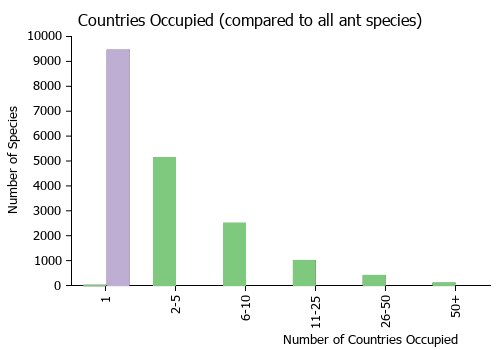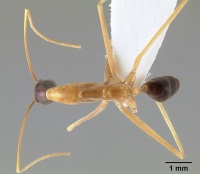Leptomyrmex nigriceps
| Leptomyrmex nigriceps | |
|---|---|

| |
| Scientific classification | |
| Kingdom: | Animalia |
| Phylum: | Arthropoda |
| Class: | Insecta |
| Order: | Hymenoptera |
| Family: | Formicidae |
| Subfamily: | Dolichoderinae |
| Tribe: | Leptomyrmecini |
| Genus: | Leptomyrmex |
| Species: | L. nigriceps |
| Binomial name | |
| Leptomyrmex nigriceps Emery, 1914 | |
L. nigriceps has been recorded in rainforest, Agathis woodland, cloud forest and low, closed riparian forest. Nests have been found in rotting stumps.
| At a Glance | • Replete Workers |
Identification
L. nigriceps resembles the other two New Caledonian Leptomyrmex (Leptomyrmex pallens and Leptomyrmex geniculatus) but can be recognized by its distinctive color pattern: dark head and gaster on an otherwise orange body. This species appears to be restricted to the ultramafic southern tip of the island, where it occurs in sympatry or parapatry with L. pallens. (Lucky and Ward 2010)
Key to New Caledonian Leptomyrmex Species
Keys including this Species
Distribution
Latitudinal Distribution Pattern
Latitudinal Range: -22.08333397° to -22.23332977°.
| North Temperate |
North Subtropical |
Tropical | South Subtropical |
South Temperate |
- Source: AntMaps
Distribution based on Regional Taxon Lists
Australasian Region: New Caledonia (type locality).
Distribution based on AntMaps
Distribution based on AntWeb specimens
Check data from AntWeb
Countries Occupied
| Number of countries occupied by this species based on AntWiki Regional Taxon Lists. In general, fewer countries occupied indicates a narrower range, while more countries indicates a more widespread species. |

|
Estimated Abundance
| Relative abundance based on number of AntMaps records per species (this species within the purple bar). Fewer records (to the left) indicates a less abundant/encountered species while more records (to the right) indicates more abundant/encountered species. |

|
Biology
Castes
Worker
        
| |
| . | |
Queens have yet to be collected.
Phylogeny
| Leptomyrmex |
| ||||||||||||||||||||||||||||||||||||||||||||||||||||||||||||||||||||||||||||||||||||||||||||||||||||||||||||||||||||||||||||||||||||||||||
Based on Barden et al., 2017. Note only selected Leptomyrmex species are included.
Nomenclature
The following information is derived from Barry Bolton's Online Catalogue of the Ants of the World.
- nigriceps. Leptomyrmex pallens var. nigriceps Emery, 1914f: 418 (w.) NEW CALEDONIA. Lucky & Ward, 2010: 42 (m.). Subspecies of pallens: Wheeler, W.M. 1934c: 109. Raised to species: Lucky & Ward, 2010: 42.
Unless otherwise noted the text for the remainder of this section is reported from the publication that includes the original description.
Description
Worker
Lucky and Ward (2010) – measurements (n = 9) HL 1.68–1.90, HW 0.92–1.01, MFC 0.20–0.25, IOD 0.54–0.60, SL 3.17–3.47, EL 0.29–0.36, WL 3.03–3.41, PW 0.75–0.86, DPW 0.27–0.33, HTL 3.57–4.11, HTWmin 0.10–0.14, HTWmax 0.14–0.18, CI 0.52–0.56, SI 3.27–3.56, OI 0.08–0.10, HTC 0.65–0.95.
As in Leptomyrmex geniculatus, but with femora unicolorous pale and head black. Gaster and head, excluding mandibles and antennae, black, with remainder of body pale orange.
Male
Lucky and Ward (2010) – measurements (n = 1) HL 1.24, HW 0.97, SL 0.36, EL 0.53, HTL 3.90, CI 0.78, SI 0.37, SI2 0.81.
Type Material
Lucky and Ward (2010) – type material examined, Syntype, 1 worker, New Caledonia: La Madeleine (Sarasin & Roux) Museo Civico di Storia Naturale, Genoa
References
- Cantone S. 2017. Winged Ants, The Male, Dichotomous key to genera of winged male ants in the World, Behavioral ecology of mating flight (self-published).
- Emery, C. 1914f. Les fourmis de la Nouvelle-Calédonie et des îles Loyalty. Nova Caled. A Zool. 1: 393-437
- Lucky, A. & Ward, P.S. 2010. Taxonomic revision of the ant genus Leptomyrmex Mayr. Zootaxa 2688: 1-67. PDF
- Lucky, A. 2011. Molecular phylogeny and biogeography of the spider ants, genus Leptomyrmex Mayr (Hymenoptera: Formicidae). Molecular Phylogenetics and Evolution 59: 281-292. doi:10.1016/j.ympev.2011.03.004
References based on Global Ant Biodiversity Informatics
- Berman M., A. N. Andersen, C. Hé ly, and C. Gaucherel. 2013. Overview of the distribution, habitat association and impact of exotic ants on native ant communities in New Caledonia. PLoS ONE 8(6): e67245. doi:10.1371/journal.pone.0067245
- CSIRO Collection
- Emery, C. 1914. Les fourmis de la Nouvelle-Calédonie et des îles Loyalty. Nova Caledonia. A. Zoologie 1:393-437.
- Jennings J. T., L. Krogmann, and C. Burwell. 2013. Review of the hymenopteran fauna of New Caledonia with a checklist of species. Zootaxa 3736(1): 1-53.
- Jourdan H., J. Konghouleux. 2005. Bilan entomologique des noyaux forestiers dits, S2 à S5, à Prony, définies par Goro Nickel SA. Rapport d'Expertise IRD / Goro Nickel SA, 15 pages.
- Jourdan H., and Joel Konghouleux. 2005. Bilan entomologique des noyaux forestiers dits, « S2 et S5 », à Prony, définies par Goro Nickel SA. IRD 16 pages
- Le Breton J., J. Chazeau and H. Jourdan. 2002. Expression de Wasmannia dans une forêt dense humide et impact sur la myrmécofaune native de litière. P 57-63. In Etude de l'invasion de la Nouvelle-Calédonie par la fourmi pionnière Wasmannia auropunctata (Roger): modalités, impact sur la diversité et le fonctionnement des écosystèmes, moyens d'une maîtrise de la nuisance. Programme INWASCAL, Conventions Sciences de la Vie, Zoologie Appliquée 13.
- Le Breton J., J. Chazeau, and H. Jourdan. 2003. Immediate impacts of invasion by Wasmannia auropunctata (Hymenoptera: Formicidae) on native litter ant fauna in a New Caledonian rainforest. Austral Ecology 28: 204209.
- Lucky A., and P. S. Ward. 2010. Taxonomic revision of the ant genus Leptomyrmex Mayr (Hymenoptera: Formicidae). Zootaxa 2688: 1-67.
- Shattuck S. O. 1994. Taxonomic catalog of the ant subfamilies Aneuretinae and Dolichoderinae (Hymenoptera: Formicidae). University of California Publications in Entomology 112: i-xix, 1-241.
- Taylor R. W. 1987. A checklist of the ants of Australia, New Caledonia and New Zealand (Hymenoptera: Formicidae). CSIRO (Commonwealth Scientific and Industrial Research Organization) Division of Entomology Report 41: 1-92.
- Wheeler W. M. 1915. The Australian honey-ants of the genus Leptomyrmex Mayr. Proceedings of the American Academy of Arts and Sciences 51: 255-286.
- Wheeler W. M. 1934. A second revision of the ants of the genus Leptomyrmex Mayr. Bulletin of the Museum of Comparative Zoology 77: 69-118.
- Wheeler W.M. 1935. Check list of the ants of Oceania. Occasional Papers of the Bernice Pauahi Bishop Museum 11(11):1-56.
- Wheeler, W. M. 1927. The ants of Lord Howe Island and Norfolk Island. Proc. Am. Acad. Arts Sci. 62: 121-153

